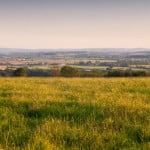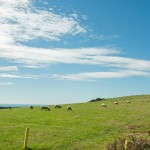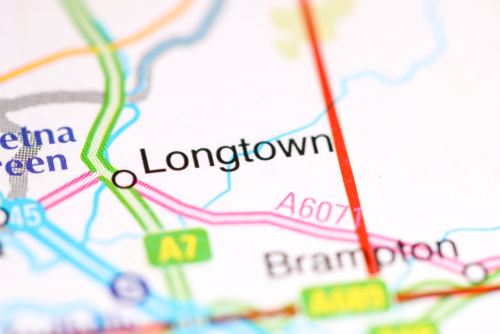
Go to the Cumbria Business Directory
A quick guide to Longtown
The small market town of Longtown is situated just south of the English/Scottish border, 3 miles (5 km) east of Gretna Green and 9 miles (14 km) north of Carlisle. This makes it the ideal place for a stopover if travelling north into Scotland or south into England for that matter. Further, it is an ideal staycation base being quiet and friendly and close to a whole host of visitor attractions. It also lies in on the east bank of the River Esk if fishing is your game.
Ok, let’s get started with a bit of local history…
A Fleeting History of Longtown
The first known historical reference to the Longtown area is the Battle of Arfderydd (aka Arderydd) which was fought around AD 573. According to some experts, it was a religious confrontation, although this remains largely unsubstantiated. The adversaries were the supposed pagan forces of Gwenddoleu ap Ceidio, pitched against the Christian army of King Riderch Hael of Strathclyde. According to records the battle raged for 6 weeks, with the pagans fighting doggedly in an attempt to avenge the death of their chieftain, Gwenddoleu. Some claim that there were as many as 80,000 casualties arising from the battle. The site of the battle, once known as Arthur’s Head, took place at Authuret, less than 2 miles south of Longtown. Sometime in the late 6th century, the area’s first church was built at the site of the present-day Autheret church.
The Border Reivers Rule
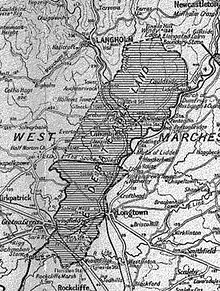
The 16th-Century Debatable Land Image Credit to Wikipedia.com
Sometime during the 15th century, local influential family and de facto head of the notorious Border Reivers, the Grahams, built a fortified tower house at the site of today’s Netherby Hall. It was reportedly constructed from the stone of an old Roman structure that had once stood at the site. Seemingly, nothing much else happened in the Longtown area for almost a millennium. It was in November 1542 that all changed, when the ‘Battle of Solway Moss’ took place at Authuret. King James V, looking to avenge recent attacks by the English on the border towns of Kelso and Roxburgh, had managed to muster an army some 15,000 strong. On the morning of 24th November, the Scots army crossed into the small border enclave of the ‘Debatable Land’, an area ruled neither by Scotland or England. The occupiers of the land were the notorious Border Reivers, who were headed by the Graham family. The Reivers were seen by the Scots as being in the pay of the English government and were particularly hated by the Stuart monarchy.
Strategic Errors Prove Costly
The Scots set about destroying the property and possessions of the Reiver families on their way to do battle. However, once the Scots crossed the Esk into England, they found themselves at a disadvantage. The river hemmed them in to both the north and west and they were also penned by the moss swamps of the Solway on the south. The battle took place just a few hundred yards to the south of present-day Longtown, although the town did not exist at the time. Their adversary was a 2,000 strong force, mostly made up of heavily armed Reiver horsemen, who were under the leadership of English nobleman Sir Thomas Wharton of Kirkby Stephen. The battle was reputedly over in less than an hour.
Old Scores settled
The disorganised Scots lost their collectedness, but on fleeing, were cut down by the Reivers, who took the opportunity to settle old scores. Of James’ 15,000 strong army only an estimated 2,000 made it back safely to Scotland. Most of the Scottish nobility who had joined the ranks were taken prisoner by the English. James was at Lochmaben when he got the news that his army had been routed. He immediately headed back to his Stirling base, where he died two weeks later at the age of only 30 years old. Some say it was the humiliation of the defeat at Solway Moss that brought about his untimely death. His new baby daughter, Mary, would go on to become the ‘Queen of Scots’.
The End of the “Debatable Lands”
It was the death of Queen Elizabeth in 1603 that signalled the end of Reivers and the Debatable Land. On hearing news of the death, the Reivers embarked on a frenzied week of pillage and plundering. However, the new monarch, James I, was determined to bring an end to their swashbuckling ways. Within a couple of years, many of the Reiver family strongholds had been destroyed, some of the clan leaders hunted down and executed without trial. Many of their family members left the area for a new life overseas, namely Ireland or America. However, one of the local families that survived the purge was the locally influential Grahams. In 1688, the local surveyor and lawyer, Thomas Denton, described Longtown as ”containing only a dozen houses, mostly built of clay, except ‘courthouse or town hall’, which was stone-built and slated”. At that time, the entire population of the parish of Arthuret was estimated at around 600.
(adsbygoogle = window.adsbygoogle || []).push({});
Longtown Gets a Bridge
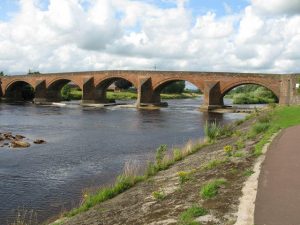
Photo © G Laird (cc-by-sa/2.0)
In 1756, the five-arched masonry sandstone bridge in the town across the River Esk was completed. This was as a result of a long campaign by local landowners, merchants, businesses and farmers for the crossing. The cost of the bridge had an estimate of £876, with most of the funding for the structure being raised locally by voluntary contributions. Active in getting Longtown Bridge built, was local landowner, Dr Robert Graham. He also went on to largely rebuild Netherby Hall, which still stands near to the town on the banks of the River Esk. Next, he drew up plans to drain 1,000 acres (405 hectares) of land just south of Longtown Bridge, on which he planned to build the ‘new town’ of Longtown. The town was laid down with its wide tree-lined streets, very much in its present-day form. The doctor then established the Graham Arms, which opened as a coaching inn to cater to travellers and mail arriving from Edinburgh.
Textiles
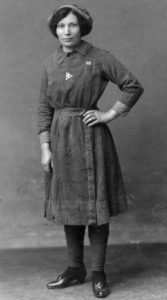
WWI munitions worker Photo Credit: Pinterest
By the early 19th century, the principal occupation in Longtown was weaving. In 1851, a bobbin mill was established, which by 1900, employed between 70 and 100 people. In 1861, Longtown gained a railway station operated by North British Railway on the Waverley line. The station stood on the north-west bank of the River Esk near Longtown Bridge. Longtown was an early ‘new town’, planned and built in the late 18th century by local influential landowners, the Graham family. The town’s population reached a peak in that same year, standing at 2,863. The numbers were swollen by the bobbin mill employees and the temporary presence of railway workers. However, by the early 20th century the bobbin market was already in decline, culminating in the mill closing in 1936.
WWI
During WWI, a munitions factory was established at Longtown which was a sub-depot of the HM Factory, Gretna complex that was the county’s biggest producer of cordite. To prevent problems with the huge influx of some 10,000 navvies and munition workers, the government implemented the introduction of the State Management Scheme. The aim of this was to curtail the sale of alcohol through the nationalisation of pubs and breweries in the local area. Why because hangovers and explosives don’t mix! The ‘experimental’ scheme was not brought to an end until 1973.
During the 1930s, the government recognised a need to provide secure storage for munitions across the UK. Three Central Ammunition Depots (CAD) were to be created, one in the South, one in the Midlands and one in the North. Longtown was chosen as the northern site but thanks to the presence of the local granite it took longer to construct than imagined and was not completed until late in WW2.
Longtown – The Modern Era
In 1969, Longtown train station was closed to passengers. The line remained open for a further year, mostly to transport freight to the nearby CAD. The station was eventually demolished along with the rail bridge river crossing.
In 2001, the town achieved national notoriety when the first animal to be found infected with foot-and-mouth disease in the country was traced back to Longtown’s livestock market. Thus, the town was quickly established as a centre for controlling the spread of the disease across the southwest of Scotland and the northwest of England.
Today, Defence Munitions Centre (DMC) Longtown is one of the town’s largest employers. Today it is the only Central Ammunition Depot remaining operational but even at its reduced capacity, it is still among the largest defence munitions sites in Western Europe.
At the 2011 national census, the population of Longtown was recorded as 2,050. An estimate of the 2018 population showed a decrease of one person.
Places to Visit Around Longtown!
- Solway Aviation Museum at Crosby-on-Eden – houses a collection of vintage aircraft and artefacts that highlight Britain’s position as a world leader in aircraft design, including the jet engine. There are also exhibits that demonstrate the historic close ties between the RAF and the Cumbria area. The museum is open every Friday, Saturday and Bank Holiday Mondays, between Easter and October.
- Netherby Hall – is grade II listed country mansion that is built on the site of a Roman fort. Originally built in the 16th century as a Pele Tower, there are 17th, 18th and 19th-century additions to the house. The house stands in 36 acres of parkland which also features a Victorian pleasure garden and a formal walled garden. You can stay overnight or simply visit for afternoon tea.
- Kirklinton Hall and Gardens – Major fire damaged in the 1970s and derelict since, the Hall itself is currently undergoing major restoration. However, there are around 12 acres of garden and grounds, consisting of 17th-century style formal terraced garden, a walled kitchen garden, tiltyard and Pell-Mell ground as well as a scenic woodland walk. A popular venue for afternoon tea, it’s open Monday to Thursday 10 am to 5 pm with a weekly market on Thursdays. Kirklinton Hall is around 4 miles from Longtown.
- The Famous Blacksmith’s Shop (Gretna Green) – is arguably the UK’s most renowned wedding venue and also an award-winning Scottish attraction. It offers a historic museum, family-friendly activities, branded shopping, fine dining and an award-winning food hall. The Shop is at Gretna Green, about 4 miles from Longtown.
- The Devil’s Porridge Museum (East Riggs) – tells the history of the area’s link with the military and the production of ammunition since 1915. The museum is sited at East Riggs about 9 miles from Longtown.
Things to Do
- Blackdyke Farm Riding Centre – is an easily accessible facility for those who may be looking to learn to ride. However, rider training can be provided up to the advanced level. As well as a viewing gallery, there’s plenty of car parking. The centre is situated at Blackford which is about 4.5 miles from Longtown.
- Walby Farm Park – has a fully-covered animal barn and the county’s largest indoor adventure play area. There are lots of hands-on animal experiences to be had. Outdoor activities include pedal go-karting, barrel train ride and a giant sand-pit with toy diggers. There’s also a farm nature trail and a number of special events put on during the school holidays. The Park is situated at Crosby-on-Eden about 9 miles from Longtown.
Getting to Longtown!
So you are visiting Cumbria and want to get to Longtown. Well fear not its easier than you think…
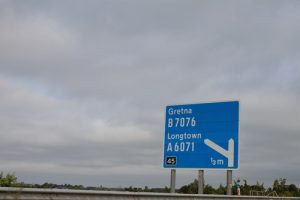
Photo credit: Sue Rae Edmundson/Shutterstock.com
By Road
It couldn’t be easier getting to Longtown by road. From the south, turn off at Junction 44 on the M6, just north of Carlisle, then head north on the A7 for about 6 miles. From Scotland, turn off a Junction 22 of the M74(M) then head east along A6071 for about 3 miles.
By Train
If you want to travel to Longtown by train from England, it’s probably best to head to Carlisle and complete the remaining 9 miles by service bus. If your travelling from Scotland, get off at the border stop of Greta Green, then take either a bus or a taxi for the remaining 3 miles of the journey.
By Bus
If you want to make the journey by bus to Longtown, then National Express make regular stops at Carlisle Bus Station. You can take the local service bus for the Borders from the same station for the 9-mile journey. It takes around 30 minutes.
By Air
Carlisle Airport is only 12 miles from Longtown but operates limited services (currently closed October 2020). Newcastle International Airport which has extensive domestic and international flights is 58 miles away.
Did you know?
- The setting for Sir Walter Scott’s famed poem ‘‘Lochinvar’’ is centred around the Longtown area. In the narrative of the much-celebrated literary ballad, the fictional young knight, Lochinvar, rides with great speed on his trusty steed to Netherby Hall, to save his true love from an imminent forced marriage.
- The site of St Michael and All Angels Church at Authuret, 2 miles from Longtown, is one of the many contenders for the burial place of the legendary King Authur. However, locations as diverse as Mount Etna on the island of Sicily and the grounds of the ruin of Glastonbury Abbey are also in the reckoning.
- During the Battle of Arfderydd, the pagan chief, Gwenddoleu’s personal bard, Myrddin Wyllt, is said to have been driven to madness and subsequently ran off into the forest. There are some who think that Myrddin is the inspiration behind the Arthurian character of Merlin.
- A coalfield was discovered close to Longtown in the 1950s by the National Coal Board, though to date it has never been mined.
- ‘Devil’s porridge’ was the colloquial name of cordite during World War I.
Where to stay in Longtown?
Being a small, relatively isolated market town, there’s only a couple of places to stay in Longtown itself. However, there’s a reasonable amount of accommodation in and around Gretna Green, which is only 4 miles away. Carlisle, which is 9 miles away, is the region’s one and only city, which obviously offers a much wider choice of accommodation. Expect to pay between £50 – £80 per night for a room at Lodge/B&B/Guesthouse/Inn style accommodation for 2 adults sharing in and around the area.
Thinking of moving?
Are you thinking of moving to Longtown? Properties in the Longtown area have sold for an average price of around £118,100 over the last year (October 2020). The most popular properties sold in Longtown during the last year were semi-detached houses, which sold for an average price of £114,100. Terraced houses sold for an average of £94,200, while detached houses fetched £148,900. Flats around the Longtown area are in very short supply. Overall, the selling price of properties in the town has dropped by 10% when compared to the previous year. House prices are currently 13% down on their peak price, which was reached in 2013.
Useful Links
Quiz Maker – powered by Riddle
FAQ’s about Longtown
Where is Longtown?
Longtown is situated just south of the English/Scottish border, 3 miles (5 km) east of Gretna Green and 9 miles (14 km) north of Carlisle.
What is the Population of Longtown?
At the 2011 national census, the population of Longtown was recorded as 2,050.
What is the average house price in Longtown?
Properties in the Longtown area have sold for an average price of around £118,100 over the last year (October 2020). The most popular properties sold in Longtown during the last year were semi-detached houses, which sold for an average price of £114,100. Terraced houses sold for an average of £94,200, while detached houses fetched £148,900. Flats around the Longtown area are in very short supply. Overall, the selling price of properties in the town has dropped by 10% when compared to the previous year.


